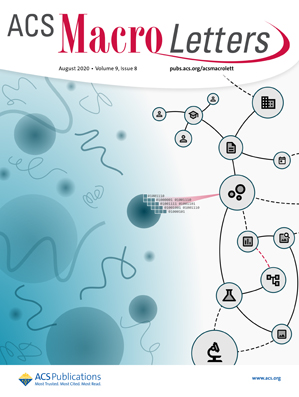Knoevenagel缩合法制备可回收聚合物防紫外线膜。
IF 5.2
Q1 POLYMER SCIENCE
引用次数: 0
摘要
紫外线(UV)辐射对人类健康、材料和环境构成严重威胁。防紫外线材料在健康、工业和环境保护方面发挥着至关重要的作用。在此之前,我们已经开发了一种通过Knoevenagel缩合(KC)反应构建可回收热固性聚合物的简便方法。本文通过KC反应,在交联网络中引入动态共价键,制备了P-TFMBTC-PCL抗紫外可回收薄膜。我们最初以香兰素和1,3,5-苯三羰基氯为原料开发了一种交联剂。随后,通过交联剂与聚己内酯(PCL)的KC反应合成P-TFMBTC-PCL。在氰乙酸末端修饰的PCL中,活性亚甲基与交联剂中的醛基反应生成动态C = C键。因此,该薄膜的抗拉强度为18.78 MPa,断裂伸长率为959.11%。此外,动态C = C键的动态交换赋予所得热固性材料可再加工性和可回收性。此外,C = C键扩展了芳环的共轭结构域,使薄膜具有抗紫外线性能,可以阻挡200 ~ 432 nm范围内100%的紫外线。总的来说,这种动态的网络化薄膜在包装、农业和汽车工业中显示出巨大的潜力。本文章由计算机程序翻译,如有差异,请以英文原文为准。
Ultraviolet-Shielding Recyclable Polymer Film Fabricated via Knoevenagel Condensation.
Ultraviolet (UV) radiation presents serious risks to human health, materials, and the environment. UV-shielding materials play a vital role in health, industry, and environmental protection. Previously, we have developed a facile method to construct recyclable thermosetting polymer through the Knoevenagel condensation (KC) reaction. Herein, an ultraviolet-shielding recyclable film, P-TFMBTC-PCL, was fabricated through the KC reaction by introducing dynamic covalent bonds into the cross-linking network. We initially developed a cross-linking agent using vanillin and 1,3,5-benzenetricarbonyl chloride as starting materials. Subsequently, P-TFMBTC-PCL was synthesized through KC reaction of the cross-linking agent with polycaprolactone (PCL). In cyanoacetic acid end-modified PCL, active methylene groups react with aldehyde groups from the cross-linking agent to create dynamic C═C bonds. Consequently, this film exhibits an exceptionally tensile strength of 18.78 MPa and an elongation at break of 959.11%. Also, the dynamic exchange of dynamic C═C bonds confers both reprocessability and recyclability to the obtained thermosetting materials. Additionally, the C═C bonds expand the conjugation domain of the aromatic ring, endowing the film with ultraviolet resistance that blocks 100% of the ultraviolet rays from 200 to 432 nm. Overall, this dynamic networked film exhibits significant potential in the packaging, agriculture, and automotive industry.
求助全文
通过发布文献求助,成功后即可免费获取论文全文。
去求助
来源期刊
CiteScore
10.40
自引率
3.40%
发文量
209
审稿时长
1 months
期刊介绍:
ACS Macro Letters publishes research in all areas of contemporary soft matter science in which macromolecules play a key role, including nanotechnology, self-assembly, supramolecular chemistry, biomaterials, energy generation and storage, and renewable/sustainable materials. Submissions to ACS Macro Letters should justify clearly the rapid disclosure of the key elements of the study. The scope of the journal includes high-impact research of broad interest in all areas of polymer science and engineering, including cross-disciplinary research that interfaces with polymer science.
With the launch of ACS Macro Letters, all Communications that were formerly published in Macromolecules and Biomacromolecules will be published as Letters in ACS Macro Letters.

 求助内容:
求助内容: 应助结果提醒方式:
应助结果提醒方式:


